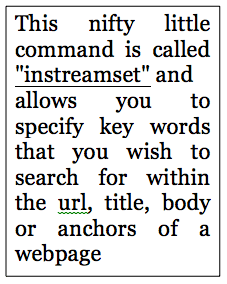How to search within the URL using Bing
For those of you familiar with boolean operators and advanced search modifers in the likes of Google and Bing (I include Yahoo, Altavista, MSN and Live Search in this as they all run off Bing’s search engine as of last year); you will know that the extremely useful field command “inurl:” does not work in Microsoft’s Bing search engine. Microsoft temporarily suspended support of this field command back in 2007 due to “what appears to be mass automated usage for data mining”. They never brought it back.
 The inurl: field command is used by recruiters and sourcers alike to find public profiles in LinkedIn, search for CVs on the web and generally exploit patterns in web addresses that can lead to candidate information. Google have a virtual monopoly on this as they are the last major search engine left that still allow you to search within the url of a web address. Well, not any more. It turns out that Bing does allow you to search within the url of a web page, in fact they have a documented search command that allows you to search within the url, title, meta tags and much more with just one command. This nifty little command is called “instreamset” and allows you to specify key words that you wish to search for within either the url, title, body or anchors of a webpage. In fact it goes one step further and allows you to combine any of these meta tags in your search.
The inurl: field command is used by recruiters and sourcers alike to find public profiles in LinkedIn, search for CVs on the web and generally exploit patterns in web addresses that can lead to candidate information. Google have a virtual monopoly on this as they are the last major search engine left that still allow you to search within the url of a web address. Well, not any more. It turns out that Bing does allow you to search within the url of a web page, in fact they have a documented search command that allows you to search within the url, title, meta tags and much more with just one command. This nifty little command is called “instreamset” and allows you to specify key words that you wish to search for within either the url, title, body or anchors of a webpage. In fact it goes one step further and allows you to combine any of these meta tags in your search.
Here’s an example: if you run the following search in Bing it will look for the letters “recruitment” in either the Title or Url of a web-page:
instreamset:(url title):recruitment
If you change this to just instreamset:url:recruitment then Bing will just search the url for these letters. I say letters as, unlike Google, Bing appears to search for the letters rather than treating our search paramater as a whole word. If you run a search for inurl:recruitment in Google, you tend only to see “recruitment” as a whole word in the url, preceded and followed by a special character such as / – . etc. This can be a pain when looking for CVs, for example, as they often appear in urls such as wwww.mycv.com which Google might not prioritise as it sees the whole word “mycv” rather than seeing “cv” as part of that term.
 Thankfully you can also filter words from the url by inserting the negative sign or hyphen in front of instreamset as follows:
Thankfully you can also filter words from the url by inserting the negative sign or hyphen in front of instreamset as follows:
site:linkedin.com -instreamset:url:dir -instreamset:url:groups “java developer”
In this example Bing filters out directory and group listings from our search for the public profiles of Java Developers.
When searching for CVs you could run a search for the following when looking for Software Developers in Dublin:
This works very similarly to a Google search for (inurl:~cv | intitle:~cv) with Bing also searching for synonyms of CV such as resumé and “curriculum vitae”.
Fundamentally Bing remains weak when it comes to indexing public LinkedIn profiles so it still doesn’t work as well as Google for LinkedIn searches but it does provide a great, comprehensive alternative to Google for finding CVs and other profile searches that would otherwise require a url search.
Which search engine do you prefer to use and why?
Reach out to us today if you’re looking for more support and training for your Recruitment team!
